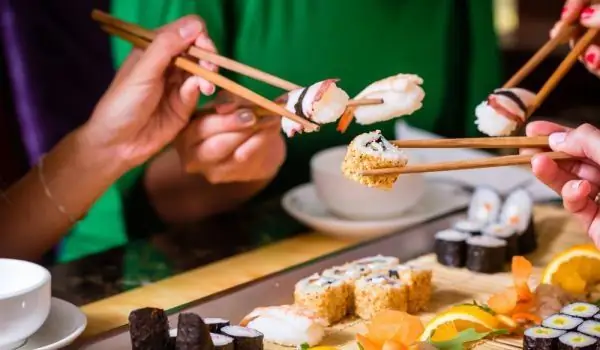2025 Author: Jasmine Walkman | [email protected]. Last modified: 2025-01-23 10:18
The word tempura means cooking technique in Japanese cuisine. More precisely - dip fish or vegetables in batter and then fry.
The term tempura is believed to have gained popularity in southern Japan. Over time, it began to be used to denote any food prepared with hot oil, including some pre-existing Japanese foods.
Tempura can be made from a variety of ingredients, mainly from fish, squid and shrimp. But you can use vegetables such as asparagus, peppers and cauliflower.
The dough it is made of consists of eggs, flour and ice cold water. Instead of the usual flour it is better to use a special mixture of starch, wheat flour and rice flour. The consistency of the mixture should be similar to cream and with many bubbles.
The products that will be fried in the dough must be pre-cut into small pieces.
Tempura is usually served with grated daikon and eaten hot immediately after cooking.
In Japan, it is available everywhere - from fast food stalls to the most elite five-star restaurants.
Outside of Japan, there are many non-traditional uses of tempura. More unusual ingredients may include nori slices, dried fruits such as bananas and ice cream (tempura - fried ice cream).
American restaurants mostly prepare tempura with a variety of meats, especially chicken and cheese such as mozzarella.

A variation is to use Panko (breadcrumbs). The use of Panko in Japan no longer meets the conditions of the dish as a tempura.
Most often, a tempura dish is made with shrimp. To prepare it, you will need 500 g of shrimp, 3 egg whites, 6 tbsp. flour, 1 tbsp. white wine, ice water, vegetable oil, salt and Wasabi sauce.
The dough is prepared by mixing flour, egg whites, ice water (enough to get the desired consistency) and white wine. Mix everything very well until it becomes a bubble cream.
Shrimp are best to be royal or tiger, as they are larger. Clean well and then dip in the dough.
Heat the vegetable oil in a pan and fry the shrimp in it until golden. Remove the finished shrimp on a napkin and allow to drain the fat. Served with Wasabi sauce.
Recommended:
Teriyaki - The Classic Of Japanese Cuisine

Teriyaki soy sauce is synonymous with Japanese cuisine. It's like pizza for Italy or blue cheese for France. Aromatic and delicious, as befits a real soy sauce, Teriyaki can be the icing on the cake for any self-respecting meat dish. And as is often the case with culinary classics, Teriyaki sauce has long since crossed the borders of Japan and won applause all over the world.
Cooking Techniques In Japanese Cuisine

You can bring a little Japanese atmosphere to your home if you imagine that you are surrounded by seas and mountains and get acquainted with the traditional culinary techniques and recipes that Japan is proud of. Natural selection Japanese cuisine follows the seasons - vegetables and spices change, dishes also change throughout the year.
Japanese Cooking Methods

There are plenty of opportunities for experimentation in Japanese cuisine. Unlike our familiar cookbooks, the Japanese emphasize cooking methods, not recipes; techniques, not ingredients. Some of the main cooking methods in Japanese cuisine are:
Let's Make A Perfect Japanese Tempura

Tempura is a typical dish of Japanese cuisine. The traditional dish is made from fried fish and vegetables in batter. You may not know that the word tempura is not a term of Japanese origin, but of Latin and is associated with the Christian tradition.
Basic Cooking Oils In Cooking! Which Is Used For What

The shelves of modern stores abound in a wide range of vegetable oils. However, most housewives use only two types of oil - one for frying, the other for dressing salads. This approach is not entirely correct. Modern nutritionists recommend that you have about five species various oils in the kitchen and alternate their use.

